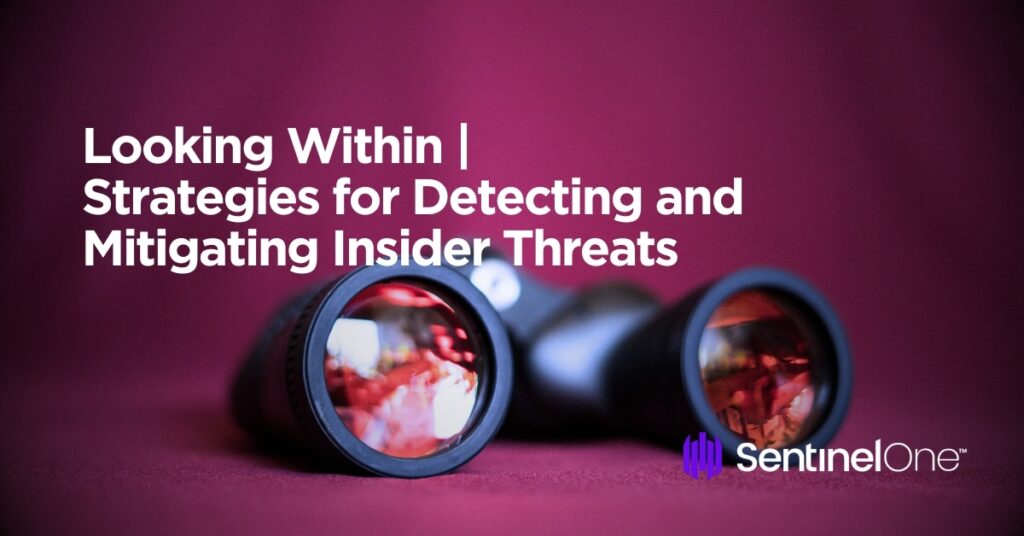Over the past decade, the digital landscape has undergone a rapid transformation, reshaping the way businesses operate and interact with data. With this paradigm shift, the nature and scope of insider threats have also evolved significantly.
As cloud adoption rates and reliance on third-party vendors rise, this has widened the attack surface for malicious insiders. With greater access to internal systems, insiders are able to leverage sophisticated attack techniques, putting sensitive data and critical infrastructure at risk.
The scope of insider threats encompasses intellectual property theft, insider trading, collusion with external actors, and financial fraud. As insiders become more adept at circumventing traditional security measures, security leaders are implementing robust strategies to address these evolving risks.
This blog post expands on how insider threats have evolved over the past decade, shedding light on the emerging challenges faced by businesses worldwide. It also explores real-world examples, showing the importance of a holistic approach that combines technology, policies, and employee education to mitigate insider threats effectively.

Understanding How Insider Threats Have Evolved
Insider threats are not a new concept. In fact, they’ve been around as long as businesses have. What’s changed is the breadth and depth that a successful insider attack can cause. In today’s digital landscape, the stakes are so much higher. Consider the following:
- 60% of all corporate data globally stored in various cloud-based solutions
- An average organization does business with 11 third parties
- The number of connected devices is predicted to reach approximately 75 billion by 2025
- More than 24,000 common vulnerabilities and exposures (CVEs) were identified in 2022
An insider threat can be anyone within an organization who has access to sensitive information and systems. This includes privileged users and administrators, contractors, third-party vendors, and even business partners.
In their most recent Cost of Insider Threats Report, Ponemon Institute confirmed that negligent, malicious, and compromised users are a serious cyber threat, with incidents rising 44% in the last two years and costing enterprise businesses over $15 million. These figures are a stark reminder of the significant risk insider threats pose to organizations of all sizes.
Other reports suggest that more than 34% of businesses are affected by such threats yearly and that 68% of security leaders now consider insider attacks and accidental breaches to be more likely than external attacks.
The Different Faces of the “Insider” Behind the Threat
Insider threats can manifest in various forms and can be placed into one of three categories based on the intent or motive behind the insider themself.
Malicious Insiders | Yahoo’s Trade Secrets Stolen By Departing Employee
Malicious insiders purposefully act against the best interests of their organization and seek to cause harm. They may steal data to sell or use as leverage for personal gain. They could also stem from disgruntled employees, contractors, partners who wish to cause the organization reputational and financial damage. Malicious insiders, in essence, intentionally misuse their access to the organization’s systems and information.
In May 2022, a research scientist at Yahoo allegedly stole proprietary information about the company’s AdLearn product after receiving a job offer from a competitor. The malicious insider downloaded almost 570,000 pages of Yahoo’s intellectual property (IP) to their personal device including source code, ad placement algorithms, and internal strategy documents.
Negligent Insiders | Microsoft Employee Exposes Login Credentials
Negligent insiders typically describe employees, vendors, or partners who engage in risky behavior due to an overall sense of being disengaged. While they consciously decide to act inappropriately, there is no malicious intent behind their actions. Negligent insiders are users who often misplace or share sensitive credentials, ignore IT policies, use unsecured devices, and neglect their security training.
In August of 2022, a number of Microsoft employees uploaded sensitive login credentials to the company’s GitHub infrastructure, giving potential attackers access to Azure servers and other internal systems. It was discovered that all identified credentials were associated with an official Microsoft tenant ID and that some were still active at the time of discovery.
Accidental Insiders | Twitter Staff Fall Victim to Spear Phishing Campaign
Accidental or compromised insiders exhibit no conscious decision to act inappropriately. These cases are often chalked up to simple mistakes made by an employee in the course of their daily work. This may include falling for a social engineering scam, opening or forwarding phishing emails and malware, misconfiguring systems, or mishandling sensitive information.
Attackers launched a phone-based spear phishing scam on Twitter employees in July 2020, calling consumer service and tech support teams and instructing them to reset their passwords. After providing their credentials and MFA codes on an attacker-controlled site, the attackers gained access to Twitter’s internal network as well as some internal support tools. With such highly privileged access, the attackers were able to hijack several well-known accounts and spread their scam campaign.
Insider Threat Protection Starts with Effective Detection
Unlike external threat actors, insiders already have legitimate access to an organization’s systems and data, making the malicious activities more difficult to detect. In the days, weeks, or even months it can take to distinguish benign and suspicious activity, a threat could have already caused irreversible damages.
Traditional security tools are often ill-equipped to handle this type of threat, as they are primarily designed to detect known, external intrusions. Effective detection of insider threats requires tools that can track anomalous behavior such as unusual or excessive access to files, irregular data transfers, and anomalies in log-in patterns. In addition, changes in work habits and signs of disgruntlement can also provide warning signs.
Know Your People
Detecting insider threats requires organizations to be vigilant in identifying behavioral changes that may signal potential malicious intent or unauthorized activities by employees. Sudden changes in work patterns or performance, especially when accompanied by unexplained financial stress or personal issues, for example, may be signs of trouble ahead.
Insiders may also display an unusual interest in accessing sensitive information beyond their job role or exhibit excessive use of privileged access rights. They might also have a tendency to violate security policies, such as sharing passwords or bypassing security controls.
Leverage Technology
Digital indicators are critical in detecting insider threats as they provide valuable clues about potentially malicious activities or unauthorized access to sensitive information. One significant digital indicator is abnormal or suspicious login activity. This could include repeated failed login attempts, multiple login sessions from different locations simultaneously, or login activities during unusual hours.
Unusual network traffic patterns, such as large data transfers or accessing restricted areas of the network, can also serve as digital indicators of insider threats. Insiders may exhibit abnormal usage of removable storage devices, attempting to copy or transfer sensitive data outside of authorized channels.
Additionally, the presence of unauthorized software or tools on an employee’s workstation can be a potential digital indicator of malicious intent. Unusual or excessive use of administrative privileges can also be an indication of insider risk.
How Can Insider Threats Be Prevented? Best Practices for Modern Enterprises
As insider threats widen surfaces for attack, enterprise leaders can implement a holistic approach that combines security policies, continuing education, and technology to prevent and mitigate these types of attacks in the long run.
Enforce Actionable Policies Focused On Access
Limiting access to sensitive information on a need-to-know basis is a fundamental step in mitigating insider threats. This includes designing policies for:
- Access control – Clearly define access privileges and permissions based on job roles and responsibilities. Implement least privilege principles to ensure employees have the appropriate level of access to systems, data, and resources.
- Acceptable use – Clearly communicate acceptable use of company resources, including computers, networks, and assets. Specify prohibited activities such as unauthorized data access, sharing credentials, or using company resources for personal gain.
- Data handling – Establish guidelines for handling sensitive information throughout its lifecycle. Specify how data should be classified, protected, transmitted, and disposed of. Enforce encryption, and data loss prevention (DLP) measures..
- Vendor and third-party access – Establish guidelines for vetting, monitoring, and managing relationships with vendors and third-party partners who have access to sensitive information or systems. Implement appropriate contractual agreements and security measures to mitigate the risks associated with external entities.
Secure All Business-Critical Assets
Begin by identifying the most mission-critical assets including sensitive data on personnel, enterprise networks, systems, intellectual property, and proprietary software. Once these assets are identified, it becomes essential to prioritize them according to their level of criticality.
Provide Regular Training & Awareness Programs For All Employees
Employees are a first line of defense against insider threats. Regular training can help them understand the risks and recognize the signs of insider threats. Training should include a wide range of cyber-related topics such as password and authentication safety, social engineering awareness, safe internet and email practices, incident reporting procedures, whistleblower policies, and remote work and mobile device security.
Create A Welcoming Culture Centered On Trust, Transparency & Respect
Fostering a positive work environment can go a long way in mitigating insider threats. Employees who feel valued and respected are less likely to pose a threat to the organization and take more accountability in protecting its best interests.
Implement An AI and ML-Based Detection & Response Solution
Security solutions such as XDR provide a holistic view of the organization’s security posture, allowing for better detection and monitoring of insider threats. Since it aggregates and correlates data from various system sources, XDR provides a holistic view of the organization’s security posture, allowing for better detection and monitoring of insider threats.
XDR leverages contextual information, such as user roles, access privileges, and historical behavior, to provide better insights into potential insider threats. This context helps security teams make informed decisions and prioritize response efforts. By establishing baselines of normal behavior, XDR can detect suspicious activities, unauthorized data access, or unusual data exfiltration attempts by insiders. XDR uses advanced analytics, artificial intelligence (AI), and machine learning (ML) algorithms to analyze user behavior patterns and identify anomalies that may indicate insider threats.
XDR also monitors user activities across endpoints, networks, and cloud environments to identify potential insider threats. It can detect unauthorized access, abnormal file transfers, changes in privilege levels, or attempts to disable security controls. Real-time monitoring and alerts enable timely response to mitigate risks.
Conclusion
From increased connectivity to the rise of remote work, advancements in technology have presented both opportunities and vulnerabilities that insiders can exploit. To stay ahead of the curve, many businesses are turning to behavioral analytics and machine learning to detect anomalies in user behavior, enabling early detection and prevention of insider threats.
Protecting businesses from insider threats requires a multifaceted approach that combines technical measures, robust security policies, and a strong security culture. Organizations implementing advanced monitoring systems, such as XDR, are better equipped to detect anomalous behavior and potential insider threats.
With a comprehensive strategy that combines technology, policies, and employee engagement, businesses can enhance their defenses and protect themselves from the damaging impact of insider threats.
Learn how SentinelOne’s Singularity XDR can extend protection from the endpoint level, maximize visibility across full environments, and automate a powerful response against insider threats. Book a demo or contact us today to see how it works.


